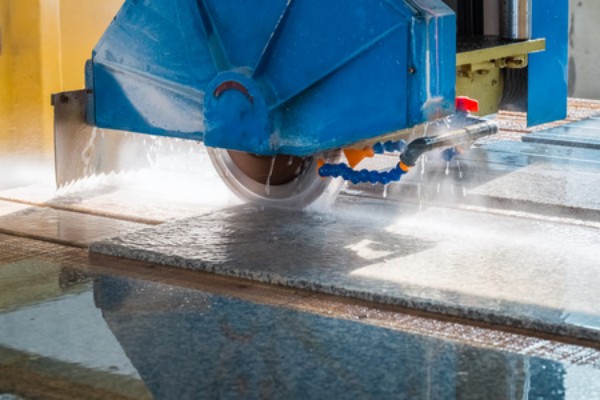Why does the thickness of granite vary during cutting?

Known for its beauty, durability, and versatility, granite is a widely used material in the construction and decoration industries. However, during the cutting process, the thickness of granite stone may exhibit variations due to a range of factors. This article will analyze the reasons for the thickness deviation of granite stone during the cutting process from aspects such as stone characteristics, cutting technology, and equipment, and propose corresponding solutions to these challenges.
Effect of granite stone properties on thickness deviation
The stone is uneven: Granite, as a natural material, exhibits inherent variations in mineral composition and structural distribution, resulting in inhomogeneities in its physical properties. These changes will lead to changes in the hardness and brittleness of the stone during the cutting process, ultimately affecting the accuracy of the cutting thickness. Uneven distribution of minerals within a gemstone can result in inconsistent depth of cut and possibly thickness deviations.
Stone textures and joints: The texture and joints of granite play an important role in determining cut thickness and accuracy. Texture refers to the orientation of mineral particles within a stone, while joints refer to the cracks or fissures present in the stone. When cutting along the grain or joint direction, the stone may crack more easily, affecting the uniformity of the cut and causing thickness variations. The presence of natural seams or cracks can also affect the structural integrity of the stone during the cutting process, thus affecting the accuracy of the cut.
Effect of cutting process on thickness deviation of granite stone
Choice of cutting method: The choice of granite stone cutting method, including diamond saw blade cutting, laser cutting, water jet cutting, etc., directly affects the thickness accuracy of the cutting. Each cutting method has unique advantages and limitations in terms of cutting accuracy.
Cutting parameter settings: The setting of cutting parameters during the cutting process is crucial to determining the thickness accuracy of the cutting. Parameters such as cutting speed, feed rate, depth of cut, and other variables directly affect cutting quality and accuracy. Unreasonable settings of these parameters will lead to problems such as stone damage, deformation, or thickness changes, ultimately affecting cutting accuracy.
Effect of equipment factors on thickness deviation of granite stone cutting
Cutting equipment accuracy: The accuracy and condition of the cutting equipment (including guide rails, bearings, and other key components) have a great impact on the thickness of the stone cut. Worn or loose equipment components can cause vibration or deviation during the cutting process, ultimately affecting the accuracy of the cutting thickness. Proper maintenance and calibration of cutting equipment are critical to ensuring consistent and accurate cutting results.
Cutting tool selection: The choice and quality of cutting tools, especially diamond saw blades commonly used to cut granite stone, can also significantly affect the accuracy of the cut thickness. The condition and installation of the diamond saw blade affect cutting accuracy. Excessive wear or improper installation of the diamond saw blade may cause deviation or vibration during the cutting process, ultimately affecting the accuracy of the cut thickness.
Solutions for minimizing thickness deviations in granite stone cutting
Choose the right stone: When purchasing granite, be sure to choose a stone with a relatively even distribution of mineral composition and structure. Choosing stones with more uniform characteristics helps reduce the impact of natural unevenness and texture variations on cut thickness accuracy. Careful selection of granite slabs for uniformity and structural integrity can minimize thickness deviations caused by the properties of the stone itself.
Optimize the cutting process: Tailoring the cutting process to specific processing requirements and equipment conditions is critical to achieving precise cutting results. Choosing the appropriate cutting method and cutting parameters based on the required thickness accuracy can significantly affect the uniformity of the cut. For applications that require high thickness accuracy, you can choose high-precision cutting methods such as laser cutting or waterjet cutting to achieve more consistent and precise cutting results.
Improve equipment accuracy: Regular maintenance and upkeep of cutting equipment, including guide rails, bearings, and critical components, is critical to ensuring cutting accuracy. Proper alignment, lubrication, and timely replacement of worn parts help minimize vibration and deflection during cutting, ultimately improving cutting accuracy. Additionally, choosing a high-quality cutting tool (such as a diamond saw blade) and ensuring proper installation can reduce thickness deviations caused by tool-related issues.
Using CNC technology: The implementation of CNC (computer numerical control) technology can significantly improve the accuracy and efficiency of cutting processing. CNC cutting equipment can accurately control multiple parameters during the cutting process, reducing the influence of human factors and improving thickness accuracy. The use of CNC technology helps achieve more consistent and precise cutting results, especially in applications that require high cutting accuracy.
Quality inspection and feedback: Conducting a thorough quality inspection of cut stone and comparing the inspection results to expected values is critical to identifying and resolving thickness deviations. Analyzing the causes of deviations and taking corrective measures can help improve cutting accuracy. Continuous accumulation of processing data and experience helps optimize the processing process and improve thickness accuracy over time.
In summary, by implementing these solutions, including careful stone selection, optimized cutting processes, equipment maintenance, use of CNC technology, and quality inspection and feedback, it is possible to minimize thickness deviations and achieve more consistent and precise results on granite stone. Cutting results are processed. These measures help improve cutting accuracy and complete construction and decoration projects that require high-quality granite stone cutting.
 English
English  Português
Português  русский
русский  Chinese
Chinese  French
French  Japanese
Japanese  Spanish
Spanish 



